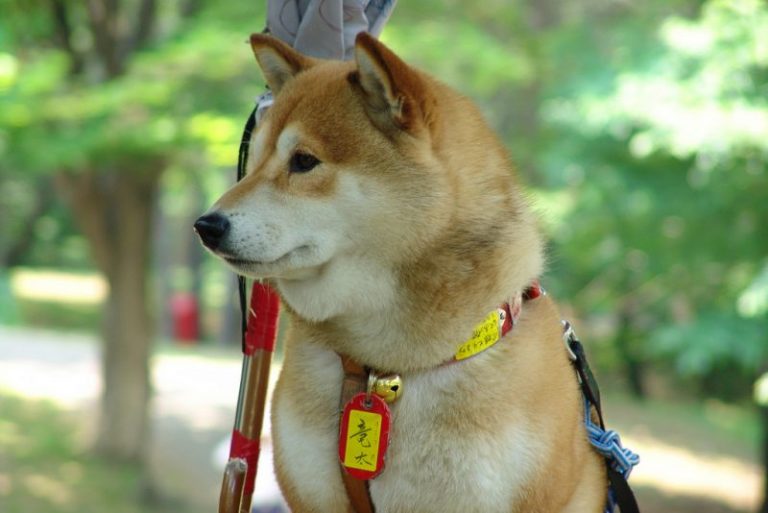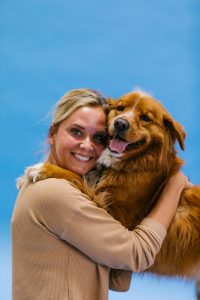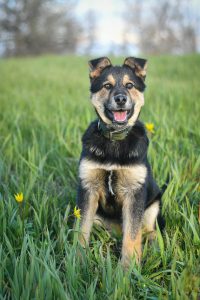One of the first things in dog training is teaching your puppy its name. Why? Because the name is a command that starts everything. When you teach your dog’s name, he will look at you for the next command.
Your dog’s name is a very similar command to sit. The moment you say his name, your pet should shift his focus towards you.
Until you teach your dog to shift his focus to you when you call his name, you cannot continue with other commands. Before that, you simply cannot start training.
Your dog should look at you for guidance and commands.
Teaching your dog to react to his name helps you establish a relationship, communication, and leadership with your pup.
If you’re still deciding on a name for a female puppy, consider checking out a list of girl dog names that could suit your new furry friend perfectly. Choosing a name that’s easy to call out and distinct can be beneficial for training and building a bond with your puppy.
Teaching your dog to react to his name helps you establish a relationship, communication, and leadership with your pup.
Here is how you do that.
How to teach your dog his name?
No matter what name you choose for your puppy, the technique is the same. You can call him Lucky, Rover, Milo, Hugo, Toby, Lea, or anything you like.
And the best way is to use positive reinforcement training to teach your dog to respond to his name. This training technique helps your pup associate his name with something pleasant, in this case, food.
If you are working with a young puppy, this works even better if you have hand feet. Hand feeding is the best thing you can do with your dog because he understands food comes from you.
Now, for this training method, you need to start in a quiet and enclosed area. Rings a bell? Yes, your living room is the ideal starting point for training.
Sit in your living room, with your dog looking at something else. Say his name in a bright and happy tone. The moment he turns to you, mark the moment with “yes”, “great”, “super”, “good job”, “bravo”, or any other word. This tells your pup it is the right reaction. Then, immediately give him a treat.
Repeat the process several times throughout the day. Soon enough, your dog will look at you the moment you say his/her name.
For the first stage of the training, you must be close to your puppy. Now, after repeating the process several times and a few days, you can move to the next stage.
Up the ante. Move across the room and say his name. Or say his name and wait for him to look at your face, not just turning toward you. Set a standard. Do not reward every behavior. Set the standard, let’s say, your dog looks at your face for two seconds. And reward only that behavior.
But mark every time your pup turns to you. Play the game at any given time in the day. You can do it while watching television, you do it while cooking dinner, or anytime your dog is near you.
Consistency is important and you want to reward only the best behavior.
Once your puppy learns to respond to your name, you can move outside. And in the beginning, start in an area with few distractions. Do not expect to go to the park and with hundreds of distractions around, your dog to look at you all the time.
Start in an area with little to no traffic. Bring a blanket, sit on it, and have your dog by your side. Let him look at other things, and then say his name. Mark and reward if he turns to you. Give lots of praises.
Simple game to maintain focus
Remember, the goal is for your dog to look at you and maintain focus on you. If you repeatedly reward looking at you, your pup will soon start offering attention without being prompted. Reinforce this with rewards to encourage your puppy to check on you.
Now, here is a simple orientation game you can play with your dog. You can do outside or inside in your living room. These are the steps.
- As always, start in an area with fewer distractions
- Throw a piece of kibble about a few feet away
- Wait for your puppy to eat the kibble. He will naturally look back at you for more. Mark this behavior with “yes”, “good job”, and so on, and then throw another piece
- Wait for your dog to turn back consistently to you
- Just before he turns to you, call his name. Wait for him to turn, mark and reward the behavior
If you play at home, you can add a bit of recall as well. Place a kibble on the floor, wait for your pet to eat it, and turn to you. Say his name and move backward a few feet. Once your dog comes to you, reward it with praise and food
- Repeat and have FUN. Remember, HAVING FUN is the most important part of dog training
Gradually increase the level of distraction. But as you increase the distractions, increase the reinforcements as well. When your dog doesn’t respond to its name immediately, go back a step and even run a bit.
Do not make negative associations with your dog’s name
This is one of the mistakes owners often make. Avoid combining your pup’s name with negative verbiage. This can change the positive association you have made and turn it into a negative reaction. Your dog might not like the sound of his name because sometimes owners combine it with verbal corrections. For example, “Rover STOP”, “Toby QUIET”, or similar correction commands.
Do not practice off-leash training in a large area where your dog can drift off before you have at least 70% reliability.
And if your puppy does not respond immediately to his name, never shout it. You can only do that if you teach your dog that a higher-pitched voice means urgency. If not, do not shout at your dog and call his name. Instead, you can walk with your dog away from any distractions and then have your puppy sit, calm down, and practice from the start.
Should you change an adopted dog’s name?
If you adopt a shelter dog, you might be inclined to change his name. This usually happens when a new dog owner doesn’t like the name of his adult dog.
Well, you can change his name only if you practice positive reinforcement and association. It is not a bad idea to change his name if you associate it with positive attention.
Patiently repeat your dog’s new name in a happy and loving tone. Eventually, he will respond to it.






